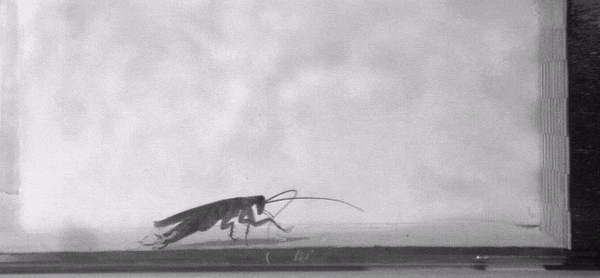There's a Reason Roaches Love Banging Their Heads Into Walls
Small roaches with robust exoskeletons use their heads "like an automobile bumper," scientists reported in a new study. When a scurrying roach's head hits a wall, its body rebounds upward at an angle, enabling the insect to scale the vertical surface more quickly than if it had applied the brakes.
The roaches' head-on approach to wall-climbing is so efficient that it inspired the researchers to design tiny robots that can ascend walls as the cockroaches do — by using their heads. [The 6 Strangest Robots Ever Created]
When animals navigate tricky terrain, an interplay between their senses and their brains helps them avoid obstacles and potentially fatal missteps. But the roaches' strategy suggests that some animals rely on their own body shapes to not only protect them from collisions, but also to channel that momentum into a successful escape maneuver, the study authors reported in the study, which was published online Feb. 13 in the Journal of the Royal Society Interface.
The researchers tested 18 male cockroaches on paper-lined running surfaces that terminated in vertical walls, recording high-speed video at 500 frames per second and using motion-tracking software to analyze the roaches' transition from horizontal track to vertical wall.
To the naked eye, it looked like all the roaches that scaled the wall did so seamlessly, the scientists noted in the study. But the slow-motion footage told another story: The roaches used two different strategies to climb the wall, one of which involved ramming the wall with their heads to "lift off" into a climbing posture.
And the head-ramming roaches were more efficient wall-climbers, the study's lead author, Kaushik Jayaram, a postdoctoral fellow in Materials Science and Mechanical Engineering with the Wyss Institute at Harvard University, told Live Science.
"In the trials where they used this head-first approach, we observed that they would run about 20 percent faster than if they landed on their legs and then climbed up the wall," Jayaram said.
Get the world’s most fascinating discoveries delivered straight to your inbox.
"In a natural environment, if they're trying to get away from a predator, a 20 percent increase in speed could be the difference between life and death," he explained.
Robots typically navigate terrain using an array of sensors, and the prospect of building a robot that could quickly change direction to climb — using momentum generated by its own body shape — was an intriguing challenge, Jayaram said. The scientists met it by designing a special "nose" for the robot that helped to pitch it upward at just the right angle, Jayaram said.
They ended up with a trapezoid nose with one edge pointing upward, mounted in front of the robot. Upon impact, the nose would graze against the wall and enable the body to rear up, Jayaram said. Though cockroaches don't have noses, the structure on the robot served the same purpose as the roaches' heads, enabling the body to change direction quickly while losing little momentum, the study authors reported.
Other robot designs have benefitted from the biomechanics of cockroaches. The insects' ability to squeeze themselves through tiny openings inspired engineers to design a tiny robot that could flatten itself to the ground to slip through narrow cracks, a feat that could one day help locate victims of earthquakes, Live Science previously reported.
"Nature can be an important teacher. We get hints of how animals might be facing these challenges when they have to do multiple tasks at the same time — running, climbing, operating in environments that they don't know," Jayaram said.
"As we start operating in more-complex environments, we can definitely learn from some of the examples that biology has — and we can definitely improve on some, too," he said.
Original article on Live Science.

Mindy Weisberger is a science journalist and author of "Rise of the Zombie Bugs: The Surprising Science of Parasitic Mind-Control" (Hopkins Press). She formerly edited for Scholastic and was a channel editor and senior writer for Live Science. She has reported on general science, covering climate change, paleontology, biology and space. Mindy studied film at Columbia University; prior to LS, she produced, wrote and directed media for the American Museum of Natural History in NYC. Her videos about dinosaurs, astrophysics, biodiversity and evolution appear in museums and science centers worldwide, earning awards such as the CINE Golden Eagle and the Communicator Award of Excellence. Her writing has also appeared in Scientific American, The Washington Post, How It Works Magazine and CNN.
 Live Science Plus
Live Science Plus







